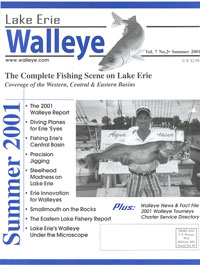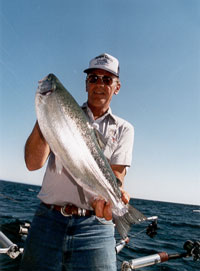Steelhead Madness
on
Lake Erie
by Jeff Frischkorn

Order Lake Erie Walleye Magazine
Three Information-Packed Issues for only $10.00
Delivered to your doorstep every March, June and September
|
Steelhead Madness
on |
|
S
teelhead trout are expected to again give Lake Erie's walleye a run for their rainbow smelt. No one
knows this likelihood better than does Ron Johnson, a charter captain from
Painesville and whose base of operations is the Grand River. "I bet we
caught between 600 and 800 steelhead last year," said Johnson. "It
was, by far, the best steelhead fishing that weıve ever seen. It was
phenomenal."
one
knows this likelihood better than does Ron Johnson, a charter captain from
Painesville and whose base of operations is the Grand River. "I bet we
caught between 600 and 800 steelhead last year," said Johnson. "It
was, by far, the best steelhead fishing that weıve ever seen. It was
phenomenal."
Officially last year Ohioıs Lake Erie boat fishermen caught a projected 33,524 steelhead. That figure is the second highest ever recorded; the highest being in 1993 when an estimated 34,000 steelhead were taken.
Though Johnson said he and his customers still took more walleye than steelhead last fishing season, on more than one occasion it was the steelhead that saved the day.
"Iıd say the ratio was something like three walleye for every steelhead but that is still impressive since we targeted walleye and not trout," Johnson said. "Had we gone after steelhead exclusively I know that our
catches would have been much, much higher."Johnson typically fishes the summer months north of the Grand River, shunting his boatıs position west to off Euclid or east off Geneva depending on the migration pattern of the fish.
Last summer the largest steelhead netted by Johnson for his customers was a 16 1/2-pound fish with a 17 1/4-pound trout being reeled in the year before. Most of the trout caught by Johnsonıs clients average 5 to 8 pounds, and his best day last summer saw 21 steelhead being poured into the boats
cooler.Such keeping is not discouraged by the Ohio Division of Wildlife. It is that agencyıs belief that trout taken from the lakeıs deep waters will probably die anyway so itıs
These catches began appearing the second week in June and didnıt ease back on the throttle until nearly the end of August. That is when the fish moved closer to shore in anticipation of the trout making their annual genetically disposed mating run up Northeast Ohioıs Lake Erie tributaries.
"It wasnıt unusual to find the steelhead schooled up with the walleye,"Johnson also said. In most cases, however, the trout would hang out in the lakeıs cooler and more clear waters while the walleye preferred slightly more tinted and warmer water.
"Thereıd be days when we actually saw the steelhead near the surface, beating up the water and feeding on bait fish," Johnson said. Johnson said that when he sought steelhead either as his tripıs main target or else for a change of pace heıd stay with the ammunition used to hoodwink walleye. Small spoons like Stingers worked especially well when finished in copper and orange coloring, Johnson said.
"Silver was good too if it had a strip of blue tape," Johnson said. "And the steelhead even would hit night crawler harnesses, which I found surprising." What steelhead do prefer is a slightly faster trolling speed, says Johnson.
By upping ones boat speed to 2.2 to 2.5 miles per hour, an angler can expect more strikes from trout. For walleye the best trolling speed is from 1.8 to 2.0 miles per hour, says Johnson."And you definitely want to use Dipsy Divers, and both sizes do work," Johnson said.
These directional divers are adjusted to a number 3 setting, says Johnson, and allowed to trail as short as 25 feet back from a planer board or 75 feet back from the boatıs stern. "Steelhead are much less boat shy than are walleye so you can get away with the shorter distances," Johnson said.
It is important that an angler maintain proper leader length and strength of line. Initially in the fishing season Johnson employs a leader of from 5 to 6 feet, lengthening the line to 6 to 8 feet as the fishing season progresses.
Johnson also prefers using 17-pound test Power Pro line a strength made necessary because of a steelheadıs often chaotic attack. "A steelhead will trip a Dipsy so you donıt have to worry about that at all. What you do need to be concerned about is the drag," Johnson said. "Most fishermen keep their drags set too tight and they lose both the fish and the lure; sometimes the diver too."
When fighting steelhead, Johnson recommends keeping the rod held at the 11 oclock position and keeping up with the fish. Trout will often charge toward the back of the boat so reeling quickly to pick up line slack is essential, Johnson says.
"We caught a lot of walleye last year but the steelhead added numbers to the cooler," Johnson said.